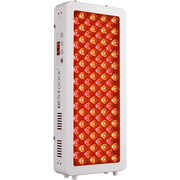To keep up with the constantly changing dynamics of healthcare, new therapeutic approaches are being sought to improve the quality of patient care and the efficiency of healthcare workers. Red light therapy is one such approach that has caught the attention of many. This non-invasive technique which employs low-level wavelengths of red light is gaining ground in hospitals.
Let’s explore the way red light therapy can speed up the healing process for patients and relieve stress and burnout in healthcare practitioners.

How Red Light Therapy Helps Hospital Patients Heal
Red Light Therapy Reduces Pain
When it comes to alleviating pain in patients, red light therapy is emerging as an impressive option by giving patients a chance to heal without much use of medicine. This method works by penetrating the skin and promoting biological activities, which in turn alleviates swelling and pain. Many individuals recovering from knee surgery and engaged in physiotherapy have considerable pain that considerably hinders their recovery. Adding red light therapy to their treatment regimen can yield remarkable improvements. Numerous patients have claimed success in mitigating their pain levels, thus allowing them to participate in the rehabilitation process more actively. This improves their recovery experience and lessens the use of opioid analgesics, which are often associated with adverse effects.
Red Light Therapy Speeds Up Wound Healing
The use of RLT has produced very good results in the healing of wounds. The therapy enhances cell growth and therefore it helps in the healing of all kinds of wounds including chronic wounds and burns. A study showed that patients with diabetic foot ulcers treated with red light therapy had accelerated wound healing closure as compared to those given standard treatment. This is because red light therapy enhances blood flow as well as collagen production, which is of great importance in reducing the length of stay in the hospital and enhancing the patient’s well-being.
Red Light Therapy Helps Injuries Heal Faster
Research suggests that red light therapy is effective for tissue regeneration and repair from injuries, including but not limited to, sprains, strains, and even fractures. It can promote healing in damaged tissues quicker enabling patients who are involved in accidents and trauma to regain back their motion and function. A patient who has suffered a severe ankle twist may benefit from red light therapy as it will reduce pain and swelling, aiding in quicker commencement of physical therapy.
How Red Light Therapy Helps Healthcare Workers Stay Healthy
It Helps Healthcare Workers Sleep Better and Feel Less Stressed
The job in healthcare involves a lot of pressure and therefore strain and burnout can occur in the medical workforce. Red light therapy comes as a solution to the challenges faced by healthcare workers, thus boosting their health.
It has been reported that sessions of red light therapy help with sleeping and improve mood. Nurses in high-stress settings have noted feelings of decreased anxiety levels and relaxation after taking red light therapy. This therapy helps to relax the individual and decrease the levels of stress hormones, thus it is important in the mental wellness of health care providers.
It Helps Prevent Healthcare Worker Burnout
The preventive side of red light treatment is also important. Healthcare organizations can utilize this treatment in wellness programs targeted at combating burnout by inducing relaxation and countering the adverse effects of stress.
Healthcare employees working in facilities that comprise red light therapy within the wellness initiatives report higher job satisfaction levels and better tolerance to the demanding nature of their duties. In addition to preventing burnout in health care professionals, this strategy also encourages a better atmosphere in the workplace that is beneficial to the employees and patients.

Where to Add Red Light Therapy in Your Hospital Care Plan
Red light therapy can enhance many aspects of your hospital care. Here's how to make it work effectively in different departments:
Physical Therapy Department
Add red light therapy sessions before physical therapy exercises to help patients move more comfortably. A 15-20 minute treatment can reduce pain and stiffness, making exercises more effective. For patients recovering from sports injuries or joint replacements, combine regular physical therapy with red light sessions to help them regain strength and mobility faster.
Surgery Recovery
For patients recovering from surgery, red light therapy can be a valuable addition to standard care. Use it 24-48 hours after surgery to help reduce swelling and discomfort. Short daily sessions can help surgical sites heal better and may reduce the need for pain medication.
Emergency Care and Urgent Treatment
Consider using red light therapy in your emergency department for patients with sprains, strains, or minor injuries. Quick treatments can help manage pain and start the healing process right away.
Long-term Care Units
For patients staying in the hospital longer, regular red light therapy sessions can help prevent muscle weakness and promote better circulation. Schedule short treatments between other care activities to help patients stay comfortable and maintain their strength during extended stays.
How to Set Up Red Light Therapy in Your Hospital
1. Choose the Right Location
First, find a quiet space in your hospital away from busy hallways and noisy areas. You'll need about 100 square feet per treatment room with enough electrical outlets for the equipment. Consider placing your red light therapy rooms near your physical therapy department - this makes it convenient for patients who need both services. Make sure the space is well-ventilated and comfortable for both patients and staff.
2. Select Your Equipment
Begin with two or three professional-grade red light therapy devices to get started. Look specifically for FDA-cleared devices that come with safety certifications and good warranty coverage. The best devices will have adjustable settings so you can treat different conditions effectively. Portable units are worth considering as they give you the flexibility to use them in different departments as needed.
3. Train Your Staff
Start by organizing thorough training sessions for all staff who will be working with the therapy devices. Your training should cover everything from basic operation to detailed treatment protocols. Make sure everyone understands how long to treat different conditions and how to properly maintain the equipment.
4. Set Up Safety Protocols
Safety needs to be your top priority. Create simple, clear guidelines for both staff and patients to follow. Include regular cleaning schedules between sessions and make sure you have proper protective equipment like eye protection available. Post easy-to-read instructions in each treatment room and make sure everyone knows what to do in case of any issues.
5. Create Treatment Programs
Develop specific treatment plans for different needs in your hospital. This includes programs for patients recovering from surgery, those in physical therapy, and even wellness sessions for your staff. Keep your treatment schedules clear and simple, and create straightforward assessment forms to track patient progress.
6. Start Small and Scale Up
Begin with a pilot program in just one department. This lets you work out any problems before expanding. Watch how things go, ask for feedback from both staff and patients, and make improvements as needed. Once everything is running smoothly, you can gradually introduce the therapy to other departments.
7. Monitor and Maintain
Keep good records of all treatments and regularly check your equipment to make sure it's working properly. Ask patients and staff how things are going and track how well the treatments are working. Use this information to make your program better over time.
Start Using Red Light Therapy to Improve Your Hospital Care Today
Red light therapy is proving to be a powerful tool that helps both your patients and your staff. For patients, it speeds up healing, helps with pain without relying heavily on medications, and can get them back on their feet faster. Your healthcare team benefits too - it helps them manage stress better and prevents burnout, which means happier staff who stay longer at your hospital.
More hospitals are starting to use red light therapy because it works. It's helping patients recover faster, keeping costs down, and creating a better environment for everyone. If you want to improve patient care and staff wellbeing at your hospital, red light therapy could be your next step forward.
References
- Glass G. E. (2021). Photobiomodulation: The Clinical Applications of Low-Level Light Therapy. Aesthetic surgery journal, 41(6), 723–738. https://doi.org/10.1093/asj/sjab025
- Zhao, J., Tian, Y., Nie, J., Xu, J., & Liu, D. (2012). Red light and the sleep quality and endurance performance of Chinese female basketball players. Journal of athletic training, 47(6), 673–678. https://doi.org/10.4085/1062-6050-47.6.08
- Larkin-Kaiser, K. A., Christou, E., Tillman, M., George, S., & Borsa, P. A. (2015). Near-infrared light therapy to attenuate strength loss after strenuous resistance exercise. Journal of athletic training, 50(1), 45–50. https://doi.org/10.4085/1062-6050-49.3.82














 Small
Small

 Moderate
Moderate

 Moderate
Moderate

 Moderate
Moderate

 Full
Full



